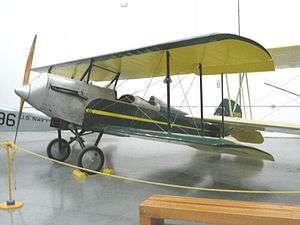American Eagle A-101
The American A-1 and A-101 were American two and three-seat biplanes of the 1920s.
| American Eagle A-1 & A-101 | |
|---|---|
 | |
| American Eagle A-101 on display in the Yanks Air Museum at Chino, California in January 2008 | |
| Role | light sporting biplane |
| National origin | United States |
| Manufacturer | American Eagle Aircraft Corporation |
| Designer | Robert T McCrum & Waverly Stearman |
| First flight | 9 April 1926 |
| Status | some flying in 2009 |
| Primary user | flying schools and private owners |
| Number built | approx 300 |
Design and development
The American Eagle A-1 was designed in late 1925 as a training aircraft to replace the World War I biplanes then in use by the Porterfield Flying School. The prototype A-1 first flew at Richards Field in Kansas City Missouri on 9 April 1926.[1] Small modifications made to the design in 1927, including ailerons on the lower wings, led to the A-101 designation. The 90 h.p. Curtiss OX-5 engine was initially fitted, but the 100 h.p. Curtiss OX-6 was fitted to later production A-101s.[2]
Operational history
A total of approximately 300 A-1/A-101 aircraft had been completed by 1929. These served successfully with flying schools and private owners for many years and several survived in flying condition and displayed in museums in 2007.[3]
Aircraft on display
Specifications (A-101)
Data from Simpson, 2001, P.41
General characteristics
- Crew: 1
- Capacity: 1 or 2
- Length: 24 ft 1 in (7.34 m)
- Wingspan: 30 ft 0 in (9.14 m)
- Height: 8 ft 4 in (2.54 m)
- Empty weight: 1,227 lb (557 kg)
- Gross weight: 2,041 lb (926 kg)
- Powerplant: 1 × Curtiss OX-5 , 90 hp (67 kW)
Performance
- Maximum speed: 99 mph (159 km/h, 86 kn)
- Cruise speed: 85 mph (137 km/h, 74 kn)
- Range: 385 mi (620 km, 335 nmi)
- Rate of climb: 500 ft/min (2.5 m/s)
See also
Aircraft of comparable role, configuration and era
(Partial listing, only covers most numerous types)
Related lists
References
Citations
- Simpson, 2001, P. 40
- Aerofiles (November 2006). "American Eagle, Roos American Eagle". Archived from the original on 7 March 2009. Retrieved 2009-04-12.
- Ogden, 2007, P. 572
- "American Eagle A‑101". Yanks Air Museum. 2017-02-03. Retrieved 2019-12-18.
Bibliography
- Ogden, Bob (2007). Aviation Museums and Collections of North America. Air-Britain (Historians) Ltd. ISBN 0-85130-385-4.
- Simpson, Rod (2001). Airlife's World Aircraft. Airlife Publishing Ltd. ISBN 1-84037-115-3.
External links
| Wikimedia Commons has media related to American Eagle A-101. |